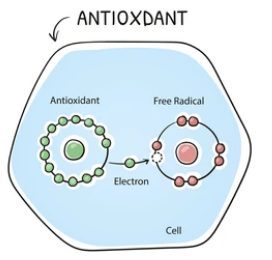The Mai brothers we are going to talk about today are not mainstream (mainly because they are expensive). But as everyone delves deeper into the ingredients and its own strength, adhering to the principle of “gold always shines”, Ergothiamine gradually becomes well-known and widely used. So today, I will take everyone together to get to know Ergothiamine.
What is L-ergothioneine?
Ergothioneine, often abbreviated as “ET,” was first discovered in 1909 by British chemist Sir Robert Robinson. It was isolated from ergot fungus, which is where the compound gets its name. However, it wasn’t until more recently that researchers began to uncover the fascinating properties of Ergothioneine and its potential impact on human health.
L-ergothioneine (EGT) is a natural antioxidant that can protect DNA proteins from oxidative damage; As a rare sulfur-containing amino acid (L-mercaptohistidine trimethyl inner salt), it is a naturally occurring cell protective agent and antioxidant in the human body, with anti photoaging and antioxidant effects. The molecular structure is shown in the following figure:

Natural Sources of Ergothioneine
One of the reasons for Ergothioneine’s popularity is its presence in certain foods. It is primarily found in fungi, such as mushrooms, and some bacteria. Additionally, it can be found in trace amounts in meat and plant-based sources. Here are some foods rich in Ergothioneine:
- Mushrooms: Various mushroom species, including shiitake, oyster, and maitake mushrooms, are excellent sources of Ergothioneine.
- Beans and Peas: Some legumes, like black beans and green peas, contain small amounts of Ergothioneine.
- Edible Plants: Spinach, garlic, and red kidney beans also contain traces of Ergothioneine.


The mechanism of action of Ergothioneine
Ergothioneine has been known for its low-key behavior, and besides the contributions of the great gods, it is also due to her strong abilities. So what is the working mechanism of Ergothioneine?
As shown in the figure, Ergothioneine can be transported to the mitochondria of the important “energy factory” of life activities through the transport protein OCTN1 on skin cells, exerting antioxidant function, thereby inhibiting DNA damage and effectively protecting against UV damage.

Ergothioneine has excellent antioxidant properties due to its ability to eliminate free radicals, reduce lipid peroxidation, and promote the body’s own antioxidant enzymes (such as the famous SOD).

The following is a VISIA-CR image of the anti-aging effect of topical 0.5% Ergothioneine:




From the images, it can be seen that Ergothioneine can effectively smooth skin texture, reduce wrinkles and fine lines; Unify skin tone, reduce spots, and eliminate dark circles under the eyes; Make pores more delicate and the skin appear younger overall. Isn’t this the raw material for rejuvenating immortals?
Ergothioneine’s rise in popularity is not unwarranted; its unique antioxidant properties and potential health benefits have caught the attention of health-conscious individuals and researchers alike. As we continue to unravel the mysteries of this “master antioxidant,” it is likely that Ergothioneine will remain a prominent figure in the field of nutrition and wellness. Whether through dietary sources or supplements, incorporating Ergothioneine into your routine may be a valuable step towards safeguarding your health and well-being.

The beauty industry has taken note of Ergothioneine’s exceptional qualities. Today, you can find a wide range of skincare products infused with this remarkable antioxidant. From serums and moisturizers to masks and creams, Ergothioneine is making its mark in the world of cosmetics.

We use synthetic biology methods to synthesize Ergothione. Please contact us at info@biosynsis.com to discuss cooperation.









